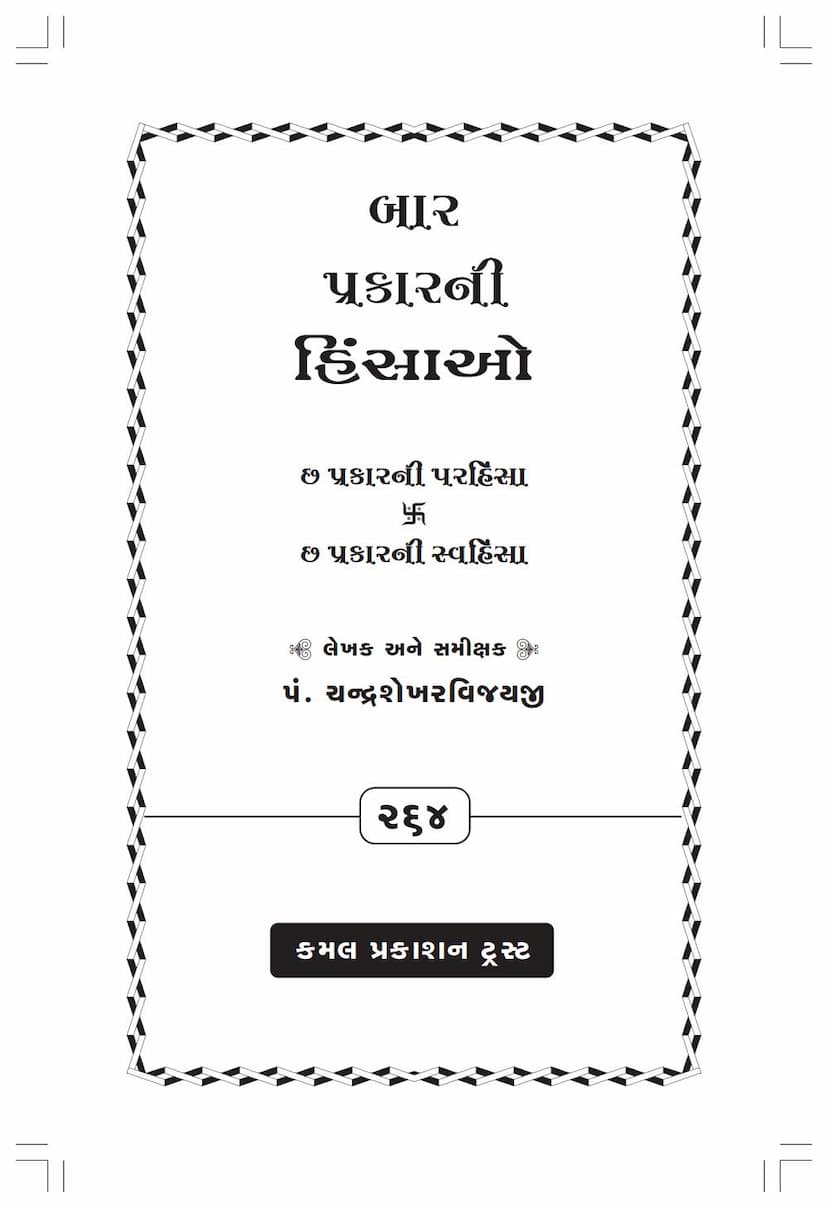Baar Prakarni Hinsa
Added to library: September 1, 2025

Summary
This Jain text, "Baar Prakarni Hinsa" (Twelve Types of Violence) by Chandrashekharvijay, published by Kamal Prakashan, delves into a comprehensive understanding of violence beyond the conventional perception of harming living beings. The book, as indicated by its title and the table of contents, categorizes violence into twelve types: six forms of "parahinsa" (violence towards others) and six forms of "svahinsa" (violence towards oneself).
The core argument presented in the book is that while the physical harm to animals (prani himsa) is often the primary focus for religious individuals, it is considered a relatively minor form of violence compared to the other eleven types, which are progressively more severe and detrimental. The text emphasizes that self-inflicted violence is more destructive than violence towards others, with the final category of self-inflicted violence being the most severe.
The book critically examines various forms of violence, arguing that ignorance of these deeper forms of violence does not absolve individuals of responsibility. It draws parallels with religious beliefs of other faiths to highlight the Jain perspective on the sanctity of all life, including microscopic beings within elements and plants, a concept emphasized in Jinagamas and attributed to Lord Mahavir.
Key Themes and Categories of Violence Explored:
The book details the twelve types of violence as follows:
Six Types of Parahinsa (Violence Towards Others):
- Prani Hinsa (Violence to Living Beings): This is presented as the most commonly understood form of violence, referring to the harm caused to animals, including humans. The text discusses how different religions view compassion, with Jainism advocating for the reverence of all life, even in the elements.
- Swajan Hinsa (Violence to Relatives/Dependents): This includes harm to family members (spouse, children, parents, in-laws), employees, and anyone considered part of one's close circle, due to neglect, mistreatment, or betrayal of trust.
- Manav Hinsa (Violence to Humans): This extends beyond direct physical harm to encompass psychological, emotional, and societal damage inflicted upon fellow humans, often driven by greed, power, or prejudice. The text explores historical examples and the systemic violence perpetrated by nations and ideologies.
- Rashtra Hinsa (Violence to the Nation): This refers to the destruction or partition of a nation, the erosion of its culture and identity, and the undermining of its sovereignty through internal divisions and external manipulation. It traces historical events, particularly in the Indian subcontinent, to illustrate this.
- Sanskruti Hinsa (Violence to Culture): This involves the destruction or degradation of a nation's cultural heritage, traditions, values, and way of life, often through the imposition of foreign ideologies or the neglect of indigenous practices.
- Vichar Hinsa (Violence of Thought): This is identified as a significant form of violence where harmful thoughts, intentions, and ideologies can lead to destructive actions and societal decay.
Six Types of Svahinsa (Violence Towards Oneself):
- Sanskar Hinsa (Violence to Upbringing/Values): This category focuses on the corruption or destruction of noble values and righteous upbringing, especially in children, through improper education, negative influences, or neglect of moral and spiritual development. The text highlights the role of parents and educators in shaping a child's character and the dire consequences of failing to instill positive values.
- Sampatti Hinsa (Violence to Possessions/Resources): This refers to the misuse or destruction of resources, whether personal wealth, religious paraphernalia, or societal assets, often driven by greed or misguided intentions. It discusses the importance of righteous use of resources and the potential harm caused by their misuse.
- Sangh (Satta) Hinsa (Violence to the Organization/Authority): This pertains to the weakening or destruction of religious or social organizations and their authority, often through internal strife, corruption, or external opposition, thereby undermining the collective well-being and spiritual guidance.
- Shastra (Mati) Hinsa (Violence to Scriptures/Intellect): This refers to the misinterpretation, distortion, or rejection of scriptures and profound spiritual teachings, leading to intellectual stagnation or the adoption of erroneous beliefs. It emphasizes the importance of correct understanding and adherence to sacred texts.
- Dharma (Kriyatmak) Hinsa (Violence to Religious Practice): This involves the perversion or neglect of religious practices and rituals, either by performing them mechanically without genuine devotion or by deviating from prescribed methods, thereby diminishing their spiritual efficacy.
- Shasan (Swaroop) Hinsa (Violence to the Essence/Nature): This is the most severe form of self-inflicted violence, where an individual destroys their own pure and virtuous nature (swaroop) by succumbing to negative emotions like anger, greed, and attachment, ultimately leading to spiritual downfall and perpetuating the cycle of suffering.
Throughout the book, the author uses a combination of philosophical discourse, historical examples, and anecdotal evidence to illustrate the pervasive nature of violence in its various forms. The text strongly advocates for a holistic understanding of non-violence (ahimsa) that encompasses not only external actions but also internal thoughts and intentions, urging readers to cultivate self-awareness and ethical conduct in all aspects of life. The book criticizes modern societal trends, consumerism, and the materialistic outlook that contribute to the erosion of moral values and the proliferation of various forms of violence.